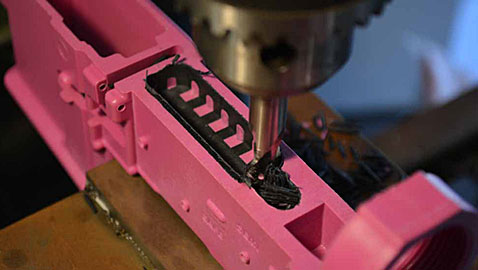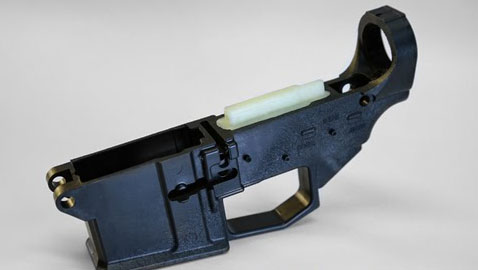Widgetized Section
Go to Admin » Appearance » Widgets » and move Gabfire Widget: Social into that MastheadOverlay zone
Feds Going After Plastic Gun Market

An EP-80 paperweight being milled into an AR lower. Contrasting colors show what needs to be machined away. Note that the core is permeated by bands of the exterior polymer, requiring that the piece be machined in order to make it useable. (Photo courtesy of TheBangSwitch.com)
Agents from the Bureau of Alcohol, Tobacco, Firearms, and Explosives have been busy in California this month seizing inventories, computers, and customer lists for the manufacturer and distributors of an unusual piece of plastic that the ATF says is a gun.
To understand what this is all about, first you need to know some basic facts about building guns. First, Americans have been legally manufacturing personal-use firearms in their basements, garages, and backyard shops since the nation was founded. Only since 1968 have commercial manufacturers been required to be licensed, but anyone wishing to build a gun for their own personal use is free to do so under federal law.
Next is the issue of what exactly constitutes a firearm. If I sell you a plain block of steel, aluminum, or plastic; that is not a gun, and there are no requirements for any sort of government paperwork, even if you plan to carve that block into a firearm. Likewise, if I do some machining on the block before I sell it to you – taking care of some processes that might be particularly difficult or require special tools – but I don’t do all of the necessary machine work – this unfinished piece of material is still not considered more than just a piece of metal – a paperweight – and still, no government paperwork, license, or tracking is required.
Where exactly the line lies between a paperweight and a firearm has been determined over the years by manufacturers submitting their unfinished pieces of metal to the ATF for a ruling on whether the amount of work completed constitutes a firearm under legal definitions. In the case of the AR-15 rifle, the ATF’s determination has been that as long as the central well where the trigger assembly goes, and the critical holes for the trigger pin, hammer pin, and the safety selector switch have not been drilled, the part is not yet a firearm, even if all other machining, drilling, and threading on the receiver have already been completed.

The EP-80, plastic precursor to an AR lower, uses contrasting color plastic to distinguish between what should be kept and what should be carved away. ATF has determined that the same design, if made from aluminum, is not a firearm, but that this plastic version is a firearm. (Photo, EP Armory)
An entire industry has sprung up around this do-it-yourself AR concept, due primarily to the relative simplicity and modularity of the AR design, the ready availability of AR parts and accessories, the widespread popularity and versatility of the gun, and the relative ease of machining aluminum as opposed to the steel of most other firearms. Government restrictions – and threats of restrictions – on manufacture and sale of these types of firearms have also fueled increased interest. And of course, where there is demand, there is opportunity. Small machine shops around the country began turning out semi-finished paperweights in the shape of AR lowers as fast as their machines would go, especially after commercial ARs got scarce and prices began climbing shortly after the election of Barack Obama.
So, in this environment of high and growing demand, manufacturers looked for ways to bring costs – and prices – down while simultaneously trying to make their products more attractive to home-builders. An innovative new entry into this burgeoning market was a company called EP Armory, who introduced an injection molded AR paperweight with a novel twist. Rather than mold the entire piece from one type of plastic, they started with a core of one color, and then molded a more durable polymer in a contrasting color around it. They also molded in little pegs with dimples at the exact points where the critical pin and selector switch holes need to be drilled. With this system, a hobbyist with nothing more than a hand drill, a rotary grinder, a sharp knife, and determination can carve away the core material, drill out the holes, and build a functional rifle – with the addition of $500 to $1000 worth of other parts.
Whether it is the ease of the EP Armory system or a mistaken technicality whereby ATF thought that EP molded the empty trigger-well first and then filled it with light-colored polymer – which would have crossed the line from paperweight to firearm – the end result is that ATF declared the unfinished EP Armory paperweight to be a firearm. That means it requires a manufacturer’s license to make and a Federal Firearms License to sell; two documents EP Armory does not possess.
In early March, ATF raided EP Armory, confiscating their inventory of thousands of AR-shaped blocks of plastic and seizing computers and customer lists. A few days later ATF sent a letter to one of EP’s largest distributors, Ares Armor, demanding that they turn over their inventory of EP AR-shaped paperweights and their customer list or else ATF would get a warrant and seize the items.
Ares Armor offered to let ATF have their EP paperweights, but refused to turn over their customer list. They went to court and were successful in obtaining an injunction prohibiting ATF from seizing their business information. ATF in turn got the injunction amended to allow seizure under a criminal warrant and a day later raided Ares Armor, confiscating their inventory, breaking open their safe, and seizing their customer lists under a warrant based on a criminal complaint of selling firearms without a license.
No arrests have been made at either EP Armory or Ares Armor.
The whole matter is now back in the courts, with our friend, attorney Chuck Michele representing both EP and Ares.
All of the thousands of customers who purchased plastic paperweights manufactured by EP Armory, whether from EP, Ares, or a third party, are now at risk of possible criminal prosecution. EP is appealing the determination that their paperweights are firearms, but ATF is expected to soon begin demanding that people turn them in or face felony prosecution.
©2014 The Firearms Coalition, all rights reserved. Reprinting, posting, and distributing permitted with inclusion of this copyright statement. www.FirearmsCoalition.org.



 MidwayUSA
MidwayUSA Ruger Firearms
Ruger Firearms SCCY Firearms
SCCY Firearms Streamlight
Streamlight Action Targets
Action Targets Gunsite Academy
Gunsite Academy
You must be logged in to post a comment Login